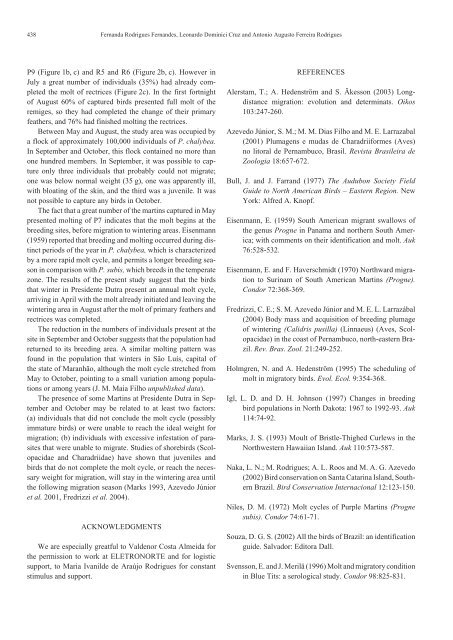Create successful ePaper yourself
Turn your PDF publications into a flip-book with our unique Google optimized e-Paper software.
438 Fernan<strong>da</strong> Rodrigues Fernandes, Leonardo Dominici Cruz and Antonio Augusto Ferreira Rodrigues<br />
P9 (Figure 1b, c) and R5 and R6 (Figure 2b, c). However in<br />
July a great number of individuals (35%) had already completed<br />
the molt of rectrices (Figure 2c). In the first fortnight<br />
of August 60% of captured birds presented full molt of the<br />
remiges, so they had completed the change of their primary<br />
feathers, and 76% had finished molting the rectrices.<br />
Between May and August, the study area was occupied by<br />
a flock of approximately 100,000 individuals of P. chalybea.<br />
In September and October, this flock contained no more than<br />
one hundred members. In September, it was possible to capture<br />
only three individuals that probably could not migrate;<br />
one was below normal weight (35 g), one was apparently ill,<br />
with bloating of the skin, and the third was a juvenile. It was<br />
not possible to capture any birds in October.<br />
The fact that a great number of the martins captured in May<br />
presented molting of P7 indicates that the molt begins at the<br />
breeding sites, before migration to wintering areas. Eisenmann<br />
(1959) reported that breeding and molting occurred during distinct<br />
periods of the year in P. chalybea, which is characterized<br />
by a more rapid molt cycle, and permits a longer breeding season<br />
in comparison with P. subis, which breeds in the temperate<br />
zone. The results of the present study suggest that the birds<br />
that winter in Presidente Dutra present an annual molt cycle,<br />
arriving in April with the molt already initiated and leaving the<br />
wintering area in August after the molt of primary feathers and<br />
rectrices was completed.<br />
The reduction in the numbers of individuals present at the<br />
site in September and October suggests that the population had<br />
returned to its breeding area. A similar molting pattern was<br />
found in the population that winters in São Luís, capital of<br />
the state of Maranhão, although the molt cycle stretched from<br />
May to October, pointing to a small variation among populations<br />
or among years (J. M. Maia Filho unpublished <strong>da</strong>ta).<br />
The presence of some Martins at Presidente Dutra in September<br />
and October may be related to at least two factors:<br />
(a) individuals that did not conclude the molt cycle (possibly<br />
immature birds) or were unable to reach the ideal weight for<br />
migration; (b) individuals with excessive infestation of parasites<br />
that were unable to migrate. Studies of shorebirds (Scolopaci<strong>da</strong>e<br />
and Charadrii<strong>da</strong>e) have shown that juveniles and<br />
birds that do not complete the molt cycle, or reach the necessary<br />
weight for migration, will stay in the wintering area until<br />
the following migration season (Marks 1993, Azevedo Júnior<br />
et al. 2001, Fredrizzi et al. 2004).<br />
ACkNOWLEDGMENTS<br />
We are especially greatful to Valdenor Costa Almei<strong>da</strong> for<br />
the permission to work at ELETRONORTE and for logistic<br />
support, to Maria Ivanilde de Araújo Rodrigues for constant<br />
stimulus and support.<br />
REFERENCES<br />
Alerstam, T.; A. Hedenström and S. Äkesson (2003) Longdistance<br />
migration: evolution and determinats. Oikos<br />
103:247-260.<br />
Azevedo Júnior, S. M.; M. M. Dias Filho and M. E. Larrazabal<br />
(2001) Plumagens e mu<strong>da</strong>s de Charadriiformes (Aves)<br />
no litoral de Pernambuco, Brasil. Revista Brasileira de<br />
Zoologia 18:657-672.<br />
Bull, J. and J. Farrand (1977) The Audubon Society Field<br />
Guide to North American Birds – Eastern Region. New<br />
York: Alfred A. knopf.<br />
Eisenmann, E. (1959) South American migrant swallows of<br />
the genus Progne in Panama and northern South America;<br />
with comments on their identification and molt. Auk<br />
76:528-532.<br />
Eisenmann, E. and F. Haverschmidt (1970) Northward migration<br />
to Surinam of South American Martins (Progne).<br />
Condor 72:368-369.<br />
Fredrizzi, C. E.; S. M. Azevedo Júnior and M. E. L. Larrazábal<br />
(2004) Body mass and acquisition of breeding plumage<br />
of wintering (Calidris pusilla) (Linnaeus) (Aves, Scolopaci<strong>da</strong>e)<br />
in the coast of Pernambuco, north-eastern Brazil.<br />
Rev. Bras. Zool. 21:249-252.<br />
Holmgren, N. and A. Hedenström (1995) The scheduling of<br />
molt in migratory birds. Evol. Ecol. 9:354-368.<br />
Igl, L. D. and D. H. Johnson (1997) Changes in breeding<br />
bird populations in North Dakota: 1967 to 1992-93. Auk<br />
114:74-92.<br />
Marks, J. S. (1993) Moult of Bristle-Thighed Curlews in the<br />
Northwestern Hawaiian Island. Auk 110:573-587.<br />
Naka, L. N.; M. Rodrigues; A. L. Roos and M. A. G. Azevedo<br />
(2002) Bird conservation on Santa Catarina Island, Southern<br />
Brazil. Bird Conservation Internacional 12:123-150.<br />
Niles, D. M. (1972) Molt cycles of Purple Martins (Progne<br />
subis). Condor 74:61-71.<br />
Souza, D. G. S. (2002) All the birds of Brazil: an identification<br />
guide. Salvador: Editora Dall.<br />
Svensson, E. and J. Merilä (1996) Molt and migratory condition<br />
in Blue Tits: a serological study. Condor 98:825-831.

















